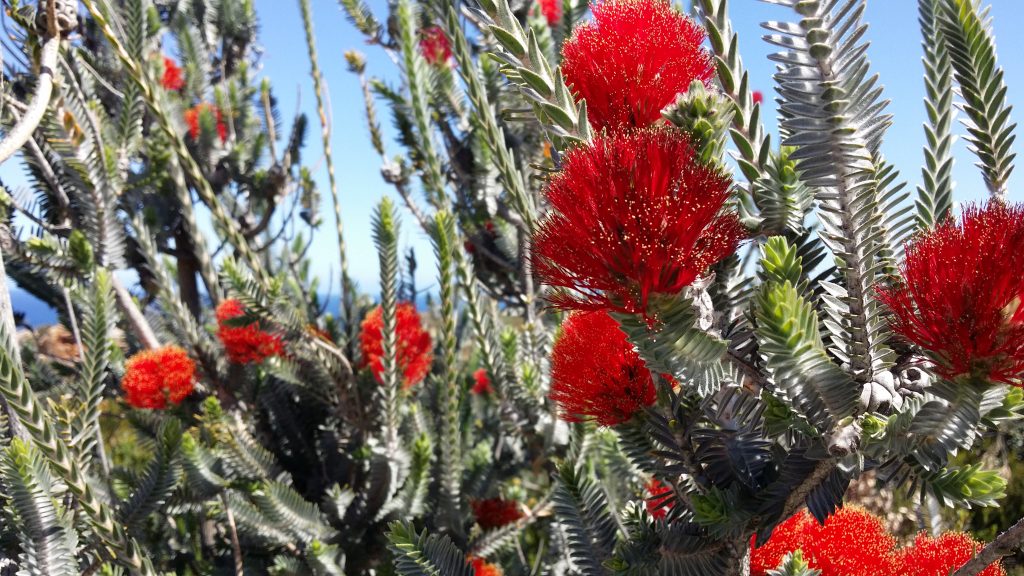Wildflower Drives and Walks
Scan the QR code to Download this page as a pdf
Ravensthorpe, Hopetoun and Munglinup
Ravensthorpe, a geological and botanical bonanza, is situated 550km from Perth on South Coast Highway (Highway 1). Hopetoun 49km south is the eastern gateway to the Fitzgerald River National Park where 1800 species of flora have been documented with almost equal numbers in the Ravensthorpe Range.
The area embraces many land forms, mountain ranges, sandplains, coastal heath and dunes and rich red soils. The vast number of species is due to a variation in minerals, soil nutrients and moderate Mediterranean climate over a relatively small area.
There are more plant species in this area than in any other of similar size in the world and the region is host to 20% of Western Australia’s flora species.
Where to see the Wildflowers
1. Fitzgerald River National Park
The Fitzgerald River National Park forms the core of the Fitzgerald Biosphere an internationally recognised Biosphere Reserve under the UNESCO Man and the Biosphere Programme which acts as a base line for evaluating the changes in the environment. It is still one of the few National Parks least infected by dieback in Australia. Please abide by any signs to help preserve this largely untouched botanical wonderland.
You will see here endemic Royal Hakea, the Weeping Eucalypt, Banksia Regalia and in spring Qualup Bells and an abundance of orchids. The National Park has year round access via the spectacular coastal drive along the sealed Hamersley Drive near Hopetoun, which extends to Hamersley Inlet where there are excellent camping facilities and walk trails.
2. The Frank Hann National Park
The Frank Hann National Park located north of the Ravensthorpe and 50km east of Lake King within the Shire of Esperance harbours a spectacular cross section of Verticordia species and heath flora, particularly good viewing later in spring.
3. Old Ongerup Road – Moir Road – Mt Madden
The Old Ongerup Road and Moir Roads are worthwhile detours for sand plain flowers and Mt Madden with its granite capping presents good examples of plants which like this environment.
4. Carlingup Road
Carlingup Road passes through the Ravensthorpe Range offering access to the Warted Yate which grows on the crest of the range about 1km in from Highway 1. It is possible with a 4WD to drive through to Nindilbillup Road, with a rough river crossing at Getenmellup. Look out for the round Ravensthorpe Bottle Brush, Lehmann’s Banksia, both yellow and red grevilleas, Qualup Bells and the Scarlet Leschenaultia.
5. Designated Flora Roads
- Designated Flora Roads are:
- Elverdton Road
- Floater Road
- Carlingup Road
- Woodenup Road
- Nindillbillup Road
Also well worth visiting are:
- Jerdacuttup Road
- Horner Road
- John Forrest Road
- Laurina Road
6. Archer Dive
The drive to Archer Lookout is a 30km round trip from Ravensthorpe and is a mix of sealed and unsealed roads suitable for 2WD. Take South Coast Highway (Highway 1) west of town, turn right on Newdegate-Ravensthorpe Road and turn right into Floater Road. Follow Floater Road and turn right at ‘Archer Drive’ sign which will take you to the lookout.
Here you will find: Warted yate trees (Eucalptus megacornuta), Ravensthorpe bottlebrush (Beaufortia orbitfolia), Red combs (Grevillea concinna) Prickly dryandra, (Banksia falcata) yellow flowers, prickly shrub Grevillea shuttleworthiana, tall yellow grevillea, Tallerack (E.pleurocarpa), blue/grey leafed mallee, Ouch bush (Daviesia pachyphylla) yellow/brown pea flowers, Buttercups or guinea-flower (Hibbertia gracilipes), and She-oaks (Allocasuarina sp)
For experienced 4WD owners only, you can take a scenic drive across the top of the Ravensthorpe Range to Carlingup Road which loops back to South Coast Highway. Sections of the drive includes steep descents and extra care should be taken.
Flowers you may see include: Goodenia scapigera, Leucopogns small furry flowers, wax flowers (Chamelaucium) often with some pink, Qualup bell (Pimelia physodes), red flowers of the Oak grevillea (Grevillea palentiloba sub sp platypoda) and Banksia near the Radio tower. On your descent look out for the dainty Boronia ternate with pink 4 petal flowers, Grass leaved hakea (Hakea multilineata) pink flowers, and everyone’s favourite the Tennis ball banksia (Banksia laevigata) with their distinctive round yellow flower heads.
Please watch out for mallee fowls and echnidas that are often seen in this area.
7. Mount Short Scenic Drive
This is a 38km round trip north west from Ravensthorpe on the Newdegate-Ravensthorpe Road. You will pass Overshot Reserve where can find many species of Eucalypt. Occasionally Australian Bustards (wild turkeys) are seen here in the evening and mallee fowl and echidnas thrive in this bushland. There is a rest area with some mining relics and a crater in the reserve.
Mt Short Road is on the right and the first section of the gravel road (up to King Road) is accessible by 2WD and it is possible to continue further during dry weather conditions, however a 4WD is recommended especially in damp weather. If you wish to climb Mt Short, the highest peak on the range (448m) you should allow a minimum of an hour up a rough path.
Flora to be seen include: Calothamnus (one-sided bottlebrush), blue mallee, banksias, dryandras, hakeas, tea trees and many more colourful shrubs.

Wildflower Drives and Walks
Ravensthorpe, Hopetoun and Munglinup
Ravensthorpe, a geological and botanical bonanza, is situated 550km from Perth on South Coast Highway (Highway 1). Hopetoun 49km south is the eastern gateway to the Fitzgerald River National Park where 1800 species of flora have been documented with almost equal numbers in the Ravensthorpe Range.
The area embraces many land forms, mountain ranges, sandplains, coastal heath and dunes and rich red soils. The vast number of species is due to a variation in minerals, soil nutrients and moderate Mediterranean climate over a relatively small area.
There are more plant species in this area than in any other of similar size in the world and the region is host to 20% of Western Australia’s flora species.
Where to see the Wildflowers
1. Fitzgerald River National Park
The Fitzgerald River National Park forms the core of the Fitzgerald Biosphere an internationally recognised Biosphere Reserve under the UNESCO Man and the Biosphere Programme which acts as a base line for evaluating the changes in the environment. It is still one of the few National Parks least infected by dieback in Australia. Please abide by any signs to help preserve this largely untouched botanical wonderland.
You will see here endemic Royal Hakea, the Weeping Eucalypt, Banksia Regalia and in spring Qualup Bells and an abundance of orchids. The National Park has year round access via the spectacular coastal drive along the sealed Hamersley Drive near Hopetoun, which extends to Hamersley Inlet where there are excellent camping facilities and walk trails.
2. The Frank Hann National Park
The Frank Hann National Park located north of the Ravensthorpe and 50km east of Lake King within the Shire of Esperance harbours a spectacular cross section of Verticordia species and heath flora, particularly good viewing later in spring.
3. Old Ongerup Road – Moir Road – Mt Madden
The Old Ongerup Road and Moir Roads are worthwhile detours for sand plain flowers and Mt Madden with its granite capping presents good examples of plants which like this environment.
4. Carlingup Road
Carlingup Road passes through the Ravensthorpe Range offering access to the Warted Yate which grows on the crest of the range about 1km in from Highway 1. It is possible with a 4WD to drive through to Nindilbillup Road, with a rough river crossing at Getenmellup. Look out for the round Ravensthorpe Bottle Brush, Lehmann’s Banksia, both yellow and red grevilleas, Qualup Bells and the Scarlet Leschenaultia.
5. Designated Flora Roads
- Designated Flora Roads are:
- Elverdton Road
- Floater Road
- Carlingup Road
- Woodenup Road
- Nindillbillup Road
Also well worth visiting are:
- Jerdacuttup Road
- Horner Road
- John Forrest Road
- Laurina Road
6. Archer Dive
The drive to Archer Lookout is a 30km round trip from Ravensthorpe and is a mix of sealed and unsealed roads suitable for 2WD. Take South Coast Highway (Highway 1) west of town, turn right on Newdegate-Ravensthorpe Road and turn right into Floater Road. Follow Floater Road and turn right at ‘Archer Drive’ sign which will take you to the lookout.
Here you will find: Warted yate trees (Eucalptus megacornuta), Ravensthorpe bottlebrush (Beaufortia orbitfolia), Red combs (Grevillea concinna) Prickly dryandra, (Banksia falcata) yellow flowers, prickly shrub Grevillea shuttleworthiana, tall yellow grevillea, Tallerack (E.pleurocarpa), blue/grey leafed mallee, Ouch bush (Daviesia pachyphylla) yellow/brown pea flowers, Buttercups or guinea-flower (Hibbertia gracilipes), and She-oaks (Allocasuarina sp)
For experienced 4WD owners only, you can take a scenic drive across the top of the Ravensthorpe Range to Carlingup Road which loops back to South Coast Highway. Sections of the drive includes steep descents and extra care should be taken.
Flowers you may see include: Goodenia scapigera, Leucopogns small furry flowers, wax flowers (Chamelaucium) often with some pink, Qualup bell (Pimelia physodes), red flowers of the Oak grevillea (Grevillea palentiloba sub sp platypoda) and Banksia near the Radio tower. On your descent look out for the dainty Boronia ternate with pink 4 petal flowers, Grass leaved hakea (Hakea multilineata) pink flowers, and everyone’s favourite the Tennis ball banksia (Banksia laevigata) with their distinctive round yellow flower heads.
Please watch out for mallee fowls and echnidas that are often seen in this area.
7. Mount Short Scenic Drive
This is a 38km round trip north west from Ravensthorpe on the Newdegate-Ravensthorpe Road. You will pass Overshot Reserve where can find many species of Eucalypt. Occasionally Australian Bustards (wild turkeys) are seen here in the evening and mallee fowl and echidnas thrive in this bushland. There is a rest area with some mining relics and a crater in the reserve.
Mt Short Road is on the right and the first section of the gravel road (up to King Road) is accessible by 2WD and it is possible to continue further during dry weather conditions, however a 4WD is recommended especially in damp weather. If you wish to climb Mt Short, the highest peak on the range (448m) you should allow a minimum of an hour up a rough path.
Flora to be seen include: Calothamnus (one-sided bottlebrush), blue mallee, banksias, dryandras, hakeas, tea trees and many more colourful shrubs.



